|
American Masters
Landscape Painters of the National Acadamy
In 1825, a group of artists and architects including Thomas Cole, Rembrandt Peale, Ithiel Town, Samuel F. B. Morse, and others formed what would soon become the National Academy of Design. Modeled on the Royal Academy of Arts in London, the National Academy included a school, a regular exhibition program, and a professional honorary organization of artists and architects.
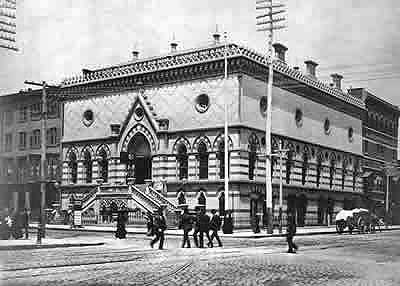
National Academy of Design Building, 1865, NYC
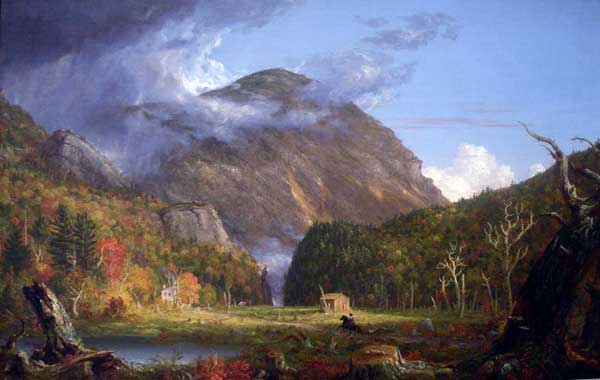
A View of Crawford Notch by Thomas Cole,
Founding member of the National Academy of Design
Today, the National Academy’s original mission, established to “promote the fine arts in America through instruction and exhibition” remains as relevant today as it was nearly 200 years ago.
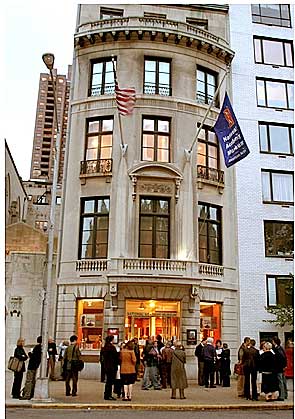
National Academy of Design headquarters today, NYC
Academicians are elected by their peers, and today there are approximately 320 living Academicians with nearly 2,000 artists and architects having been elected since the institution was founded. These artists and architects represent some of the most distinguished practitioners in their respective fields. Collectively, they comprise a legacy of American visual culture that is passed down from generation to generation with the election of new Academicians each year.
This exhibit at the Blue Hill Bay Gallery commerorates this legacy by showcasing the paintings by National Academy members currently in the gallery.
Just scroll down to see each painting
William Lester Stevens, NA (American, 1888-1969)
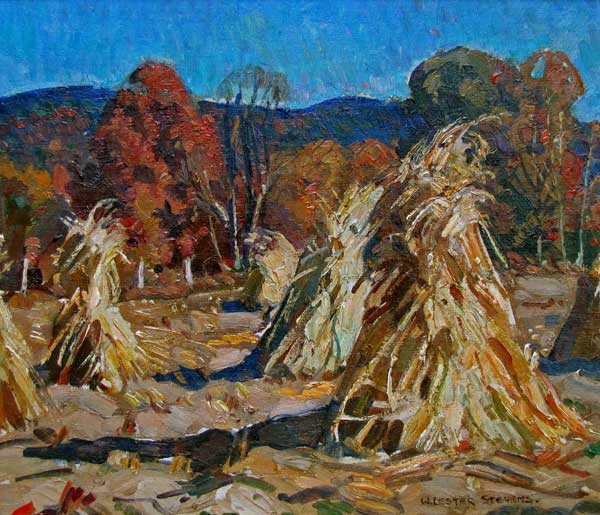
William Lester Stevens, NA (American, 1888-1969)
Autumn Haystacks
14 x 16 Oil on artist's board
Period carved gilt frame 17-1/4" x 19-1/2"
Provenance: the John F. Gale Collection, Cambridge, MA
$7500
Born in Rockport, Massachusetts, Stevens spent four years at Boston's Museum of Fine Arts School, where he studied under Edmund Tarbell, among others. Primarily an oil painter, he also used watercolor and acrylics. He is best known for his post-impressionistic landscapes. Throughout the course of his long career, Stevens taught, first in Rockport, then at Boston University (1925-1926) and Princeton (1927-1929), and during the Depression at Grand Manan.
He was a National Academician and a member of the American Watercolor Society; a founding member of the Rockport Art Association; Springfield, MA Art League; Guild of Boston Artists; Gallery on Moors; New Haven Paint and Clay Club, CT; Gloucester Society of Art; North Shore Art Association; Boston Watercolor Club and the New York Watercolor Club. He won art awards at the Corcoran Gallery, Washington, DC; American Watercolor Society; New Haven Paint and Clay Club; Springfield Art League; Salons of America; Washington Watercolor Club; North Shore AA; Rockport AA and more. He painted USPO murals in Dedham and Rockport, MA, the Boston City Hall, the Louisville, KY Art Museum and several schools in Boston. References: Movalli, Charles, American Artist (April 1986); Who’s Who in American Art (1947); Who Was Who in American Art (vol. 3, p. 3171-72).

William Lester Stevens (American, 1888-1969)
Gloucester Evening
Oil on Canvas, 16 x 20 in.
$6500
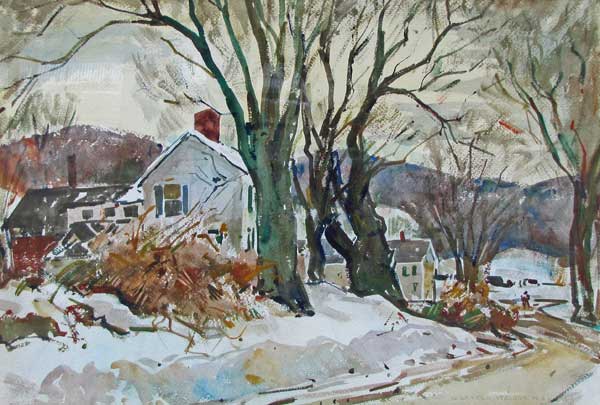
William Lester Stevens (American, 1888-1969)
Winter in the Berkshires
Signed "W. LESTER STEVENS N.A." l.r.
Watercolor 16 x 22, Framed 25 x 31
$2950
Paul Strisik N.A. (1918-1998)
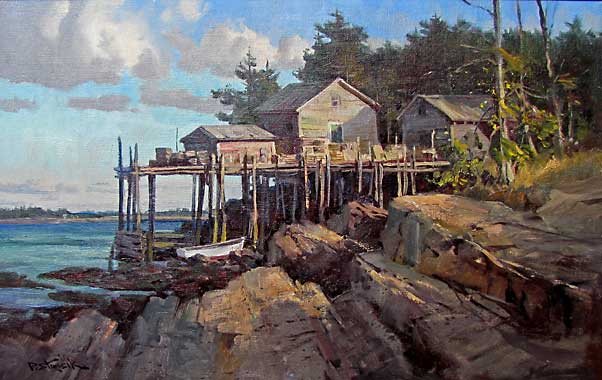
Paul Strisik N.A. (1918-1998)
Maine Coast
Oil on Canvas 16 x 24
Framed 22 x 30, Condition: excellent
$8000
Born in Brooklyn, New York, Paul Strisik became a resident of Rockport, Massachusetts, where he did landscape painting that brought him national recognition. After serving in the Navy during World War II, he studied at the Art Students League in New York City and with Frank Vincent DuMond. In 1953, he moved to Rockport, where he was active in the Art Association and other local civic organizations.
He was a member of the National Academy of Western Art, the American Watercolor Society, and the Oil Painters of America. During his long career, he won 185 awards including 16 gold medals. He and his wife, Nancy, also maintained a home in Santa Fe for 12 years, and in 1996, he was honored as Artist of the Year by the Santa Fe Rotary Club. He was widely respected for his willingness to share his talents with young artists, and taught numerous workshops including at the Scottsdale Artists' School. He wrote several books, his last one being "Capturing the Light in Oils." A reviewer in "Art Talk" quoted him: "God's light on a blade of grass is such a miracle, and so difficult to capture in paint; it is worth a lifetime of trying" (10/98). He died July 22, 1998 at his home in Rockport.

Paul Strisik N.A. (1918-1998)
Sparkling Harbor, Maine
Oil on Canvas 10 x 14
Framed 16 x 20, Condition: excellent
$5000
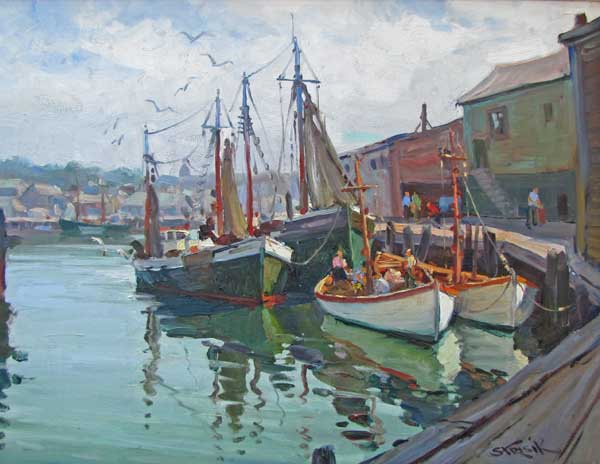
Paul Strisik N.A. (1918-1998)
Gloucester Harbor
Oil on Canvas 24 x 30
Framed 31 x 37, Condition: excellent
$9500
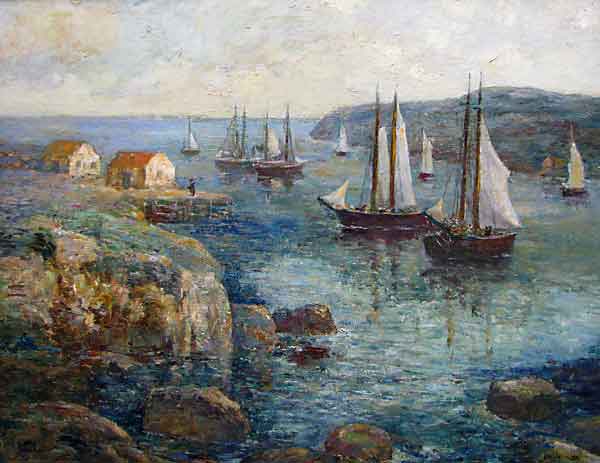
Paul Bernard King, N.A. (1867-1947)
Monhegan Island Harbor
25 x 30 Oil (relined),Antique carved frame 31 x 36
Price available upon request
Versatility, artistic maturity and mastery of technique and medium are hallmarks of Paul King's art. His diverse works of portraits, landscapes, rural scenes and illustrations establish his reputation in the first quarter of the century.
From 1906, when his oil painting "Hauling in the Anchor Line" (date and location unknown) captured the Salmagundi Club's top two prizes, King regularly received recognition. His merit was freely acknowledged by his artist peers, as well as by the critics and the public.
King was born in 1867 to a Buffalo, New York goldsmith. Apprenticed there to a lithography firm, he became an accomplished printer. King later studied at the Art Students League of Buffalo and, from 1901 to 1904, at the New York Art Students League with Henry S. Mowbray. While a student, he was an illustrator for "Life" and "Harper's" magazines. From 1905 to 1906, King studied in Holland with Willy Sluiter, Evert Pieters and Bernard Bloomers.
He was a board member of the Philadelphia School of Design for Women, serving as vice president and acting president, from 1908 to 1921. In 1921, he moved from his long-time home in Germantown section of Philadelphia to Stony Brook, Long Island, where he died in 1947.
Memberships: Allied Artists,America Federation of Arts, Artists Aid Society, Artists Fund Society, International Society of Arts and Letters, Pennsylvania Academy of Fine Arts, Philadelphia Art Club, Salmagundi Club
Public Collections:Albright-Knox Gallery, Buffalo; Butler Art Institute, Youngstown, Ohio; National Gallery of Art, Washington, D.C.; Reading Museum, Pennsylvania; Los Angeles Museum; Houston Art Museum; New Pantheon, Nashville, Tennessee. (From "American Art Analog").
Biography from Roughton Galleries,Inc

Sunset, Monhegan
Jay Hall Connaway, NA (1893-1970)
Signed "Connaway" l.r., titled reverse.
Oil on board, 24 x 29 in.
$5000
Born in Liberty, Indiana, Jay Hall Connaway was fascinated by coastal life and marine scenery, an attraction that had profound effects on his life and artwork. After periodically studying at the Art Institute of Indianapolis and at the Art Students League with William Merritt Chase, Connaway traveled throughout the United States.ndertake further study in Paris at the Academie Julian and at the Ecole des Beaux-Arts. Encouraged by Robert Macbeth (Macbeth Gal., NYC) and artists Paul Dougherty, Emil Carlsen, and Frederick Waugh, he spent 1922-25 painting at Head Harbor, ME. From 1929-31 he was painting in Brittany and Paris, sponsored by Macbeth and Milch. Returning in the midst of the Depression, he and his family settled at Monhegan Island, ME year-round from 1931 until 1947. when they moved to Dorset and then Pawlet, VT. A popular landscape painter with robust brushwork, he gave lectures and demonstrations around the country. He ran a summer school at Monhegan until 1947, and at Dorset, VT until 1966. His work was featured in an unprecedented 85 one-man shows, evidence of his successful and widely renowned career as a skilled sea painter.

Frank Knox Morton Rehn, NA (1848-1914)
Evening on Gloucester Bay
Oil on Canvas, 16 x 28 in.
$6000
Frank Knox Morton Rehn was born in Philadelphia in 1848 and attended the Pennsylvania Academy of the Fine Arts. A renowned marine painter, he was well known in both the Philadelphia and New York art worlds. His luminist seascapes of Maine and Massachusetts were highly popular and critically acclaimed. He was elected a full member of the National Academy of Design and president of the prestigious Salmagundi Club.
Rehn won first prize at the St. Louis Exposition of 1881, gold medals at New York City’s Prize Fund Exhibition of 1886 and the American Art Society exhibition of 1901, and the bronze medal at the Buffalo Pan-American Exposition of 1901. His work is featured in the Corcoran Gallery of Art, the Newark Museum, the Pennsylvania Academy of the Fine Arts, and the Detroit Museum of Art.

Alfred Thompson Bricher, ANA (1837-1908)
Figure in a Boat Near Shore
Monogrammed l.r., labels from Barridoff Galleries, Portland,
Watercolor and gouache en grisaille on paper,
sight size 2 3/8 x 6 in. framed
$2500
An Associate of the National Academy, Alfred Thompson Bricher was known especially for his serene, luminist seascapes, reminscent of works by Fitz Hugh Lane and Martin Johnson Heade. Born April 10,1837, Portsmouth, NH, Bricher grew up in Newburyport, MA. Largely self-taught, Bricher studied art at Lowell Institute, Boston in the 1850's. In the 1860s he followed his contemporaries to the White Mountains, and was active in Boston and Newburyport, MA until 1868 when he moved to New York. He executed his best work during the 1870s-80s when he spent many summers painting on the coasts of Massachusetts, Maine (Monhegan Island), and Rhode Island (1871-76), as well on Long Island, especially at Southampton.
Bricher was a significant second-generation Hudson River School landscapist and marine painter who is considered to be the last of the relevant American luminists. He is best known for his marine paintings depicting New England shorelines, in which crashing waves show the dynamic forces of nature.With ease and finesse he captured the natural ambiance around the ocean and its coasts and the artist’s reverence for the presence of what is before him is apparent.
Today A.T. Bricher is considered one of the finest marine painters of his era, and his work is in great demand because each of his canvases and watercolors show resplendently and with confident brushwork how nature looked during the late 19th and early 20th centuries.
|

WILLIAM THON, NA (1906-2000)
MAINE WILDERNESS
36 x 22 Oil on masonite
45 x 31 gilt frame, with linen and gilt liners
Provenance: Midtown Galleries, New York Cit
$3500
William Thon was an American artist noted for highly abstracted landscape paintings. He was born in New York City in 1906, and spent his childhood summers camping on Staten Island. He also developed a great love of travel, and in 1933 made an eight-month voyage to the Cocos Islands in the Pacific. He debuted as a professional artist in 1939 at the Corcoran Gallery Biennial exhibition.
He joined the Navy during World War II, and shortly after the war won the Prix de Rome, a fellowship in Rome to the American Academy, which he later served as trustee. Recognition for him continued with his participation in the 1942 "Artists for Victory" exhibit at the Metropolitan Museum of Art, and in 1944, Midtown Galleries in New York held his first one-person show. This gallery then continued to be his representative throughout his career. He had subsequent solo exhibitions at Smith College Art Museum, Fort Wayne Museum and Farnsworth Museum in Rockland, Maine. He earned an honorary Doctor of Arts from Bates College in Lewiston, Maine in 1957, and was a member of The American Academy and Institute of Arts and Letters, as well as the National Academy of Design.
In 1947, the year-long study at the American Academy proved highly influential on his career, especially with him beginning to paint as much with watercolor as oil. Returning to America, he submitted a watercolor into the 1949 exhibition of the National Academy of Design, and that year was voted into Academy membership. From thereon, he exhibited frequently at the Academy and won prizes including the Benjamin Altman Prize in 1951, 1954, 1961, 1967 and 1969. In 1951, Thon received a grant from the American Academy of Arts and Letters. He returned often to Italy, and in 1955 served in Rome as Artist-in-Residence at the American Academy. However, especially influential was his beloved home countryside at Port Clyde, Maine, where he had made his home just after World War II.
Thon chose to live in the relative isolation of Maine on a peninsula overlooking the sea, a quiet place, especially in winter. He chose the company of sailors, craftsmen, lobstermen, a few fellow artists, and his beloved wife Helen. This area is credited as providing a major breakthrough stylistically because of his discovery of an abandoned quarry near his property. Here he did numerous and increasingly abstract paintings of spidery trees with rectilinear slabs of interspersed granite. While still based in nature, these were by far the most abstract of any of his paintings.
Each season, William Thon would send his paintings off to the prestigious Midtown Galleries in New York City as though sending them on a journey to a strange and distant land. Each bore the imprint of his intense connection to raw and wild things, beautifully contained within the artist's capable and generous temperament. Thon's paintings of Maine had little to do with rural nostalgia or American historical values or the pathos of human relationships. His was a living Maine, a timeless and vital place reflecting his own passion for its rough, beautiful forests, intemperate seas, and the scatter of wooden buildings along its rugged shoreline.
He died at his home in Port Clyde on December 6, 2000 at age 94. He had continued to work after macular degeneration had left him legally blind. From his estate gift of four million dollars, the Portland Museum of Art, Maine, received the biggest cash gift to that time. William Thon was awarded innumerable prizes and is represented in over 60 museum collections including The Metropolitan Museum of Art, The Brooklyn Museum, The Hirshhorn Museum, The Butler Institute of American Art, The Columbus Museum of Art, and in Maine, The Farnsworth Art Museum, The Portland Museum of Art, and The Ogunquit Museum of Art.
Sources:
David Dearinger, Paintings and Sculpture in the Collection of the National Academy of Design, 1826-1925, Volume One.
The New York Times obituary of the artist, December 18, 2000
Wikipedia, http://en.wikipedia.org/wiki/William_Thon
Caldbeck Gallery
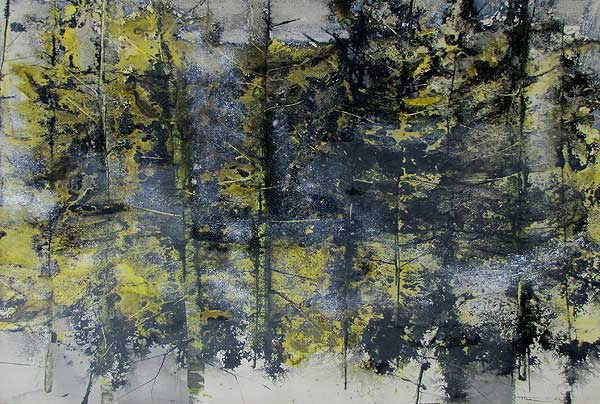
WILLIAM THON, NA (1906-2000)
LIGHT MIST
20 x 26 Watercolor
27 x 33 gilt frame with gilt and linen liners
Provenance: Midtown Galleries, New York City
$1500

(Robert) Bruce Crane, NA (1857-1937)
Robert Bruce Crane was born in New York City on October 17, 1857. The son of Solomon Bruce Crane and Leah Gillespie, he was educated in New York's public schools and was exposed to the city's galleries and museums by his father, himself an amateur painter. By the age of seventeen, Crane had moved to Elizabeth, New Jersey, where he was employed as a draftsman by an architect and builder.
He soon decided to devote his career to painting, and about 1876 or 1877 sought the guidance of the landscape painter Alexander H. Wyant, with whom he subsequently shared a close friendship until Wyant's death in 1892.
Between 1878 and 1882, Crane attended the Art Students League in New York and traveled to Europe for further study. In the United States during this period, he painted in New Jersey; East Hampton, Long Island; and the Adirondacks. He wrote to his father from the Adirondacks that among the influential painters working nearby at the time were Eastman Johnson, George and James Smillie, and Samuel Coleman, and he described the dramatic terrain: "Went to the famous Rainbow Falls which several artists have tried to paint . . . Wyant and Hart among them . . . over the top comes tumbling the water which strikes every few feet throwing a spray which catches the sun giving a most charming as well as wonderful appearance."
Crane spent time in East Hampton, on the eastern end of Long Island, during the summer of 1880 or 1881 and possibly during other summers. From there he wrote his father that the painters "Stimson, Dellenbaugh, Moran, Robbins and Coleman are here . . . I have finished the study of an old house . . . and the artists say that [it] is exceedingly good." In another note he described some of his typical subjects at this time: "I have been working on a 20 x 30 [inch] subject, a row of apple trees, gigantic in size . . . I commence in a few days the study sheep."
In these early works, Crane painstakingly reproduced the pastures, hayfields, and barnyards of rural East Hampton. A critic later remarked that "Troubled or placid skies, the bright luminous atmosphere of a summer's day, or the gray tones of autumn were given in these pictures, not only with truth to nature and a certain poetic sentiment, but with a brilliant sparkling quality of effect.
Source:
Clark, Charles Teaze; "Bruce Crane, Tonalist Painter", Antiques Magazine, November, 1982.
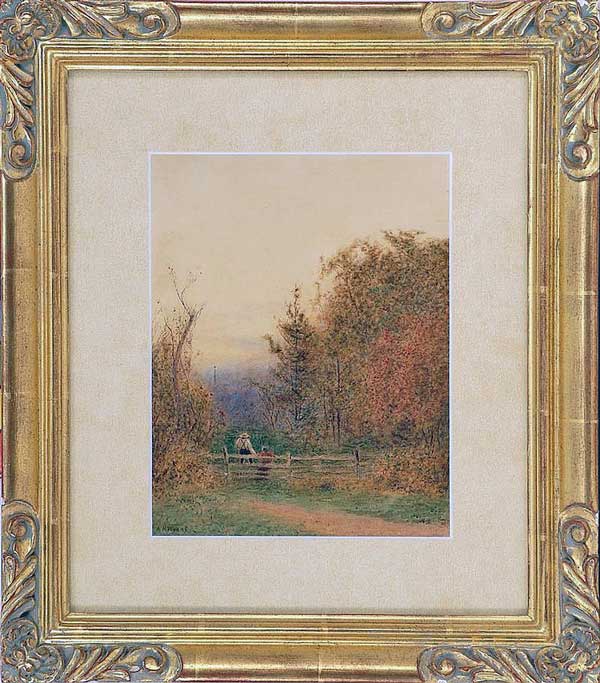
ALEXANDER HELWIG WYANT, NA
(1836-1892)
"In the Woods"
Signed lower left "A.H. Wyant"
Provenance: The Marbella Gallery, New York.
Watercolor on paper, 9 3/4" x 7 1/2" sight. Framed 12 x 10
$1200.
Born in Evans Creek, Ohio, Alexander Wyant was a tonalist landscape and genre painter who was part of the Hudson River School painters but who is credited with making the transition within that School from a tight, restrictive style to the freer methods of Impressionism. He was much influenced by the French Barbizon impressionists, and his signature grand eastern mountain landscapes with dramatic cloud formations were much sought after during his lifetime.
He was raised in a family of itinerant farmers and early apprenticed to a harness maker and sign painter. His commitment to becoming an artist resulted from his seeing landscapes by George Inness Sr. in an exhibition in Cincinnati in 1857. He made a trip to New York to meet Inness, who recognizing the young man’s talent, helped him secure to the patronage of Nicholas Longworth of Cincinnati.
This financial help enabled Wyant to study for a year at the National Academy in New York City, where he settled for a short time in 1863. By 1865, he was in Karlsruhe, Germany with Hans Fredrik Gude, a Norwegian artist of the Dusseldorf school. Wyant also lived in England and was much influenced by the landscapes of J.M.W. Turner. In 1867, he returned to New York City where he established a studio and from where he traveled frequently into the Adirondack and Catskill Mountains. The completion of many canals, the construction of transcontinental railroads, the opening of the West, and significant technological advancements that took place during the Victorian Era serve as backdrops to Wyant's time as an artist. The Hudson River School of landscape painting was in its waning years.
In 1873 he was part of an expedition into New Mexico and Arizona where he painted many sites including Canyon de Chelly in Navajo country. On this trip, he suffered a stroke, which paralyzed his right hand and forced him to paint with his left. It was said that this led to a freer style, lighter tone, and looser technique, all of which paralleled the growing taste of the American public. In 1889, Alexander Wyant moved to Arkville, New York in the Catskills, and died there three years later, in 1892.
He was a member of the Century Association and the National Academy. Exhibitions included the following venues: :National Academy of Design, 1865-92; Brooklyn Art Association, 1867-92; Boston Arts Club, 1877-82; Pennsylvania Academy of Fine Arts, 1879-81; Art Institute of Chicago; and Metropolitan Museum of Art. Public collections that include Wyant’s work can be found in the National Museum of American Art, Brooklyn Museum, Metropolitan Museum of Art, Toledo Museum of Art, Tennessee State Museum, and the Kentucky Art Museum.
Credit
http://alexanderwyant.org/home
|
Living Members of the National Academy
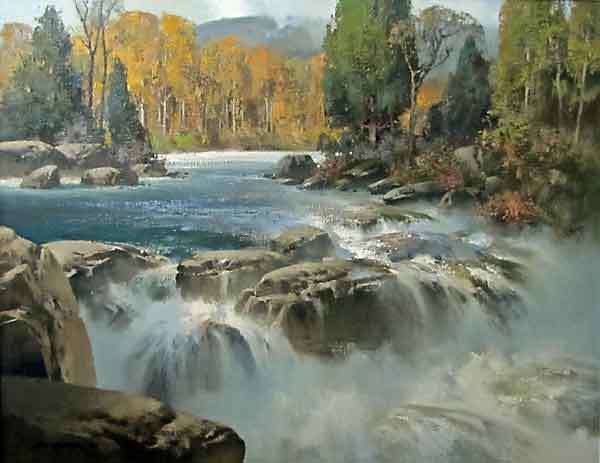
THOMAS ANDREW NICHOLAS, NA
Sunlit Falls
30 x 36 Oil on Linen
$14,000 Framed (38 x 44)
Born Middletown, Connecticut, in 1934, Tom Nicholas has been at the forefront of American landscape painting for almost a half century. He has earned an esteemed position as one of the country’s most widely recognized landscape painters. After formal studies as a scholarship student at the School for Visual Arts, NYC, from 1953-56, he was awarded a Greenshield Grant for two years of independent painting abroad and in the USA. His paintings are noted for their elegant composition, fine detail and romantic sensibility.
Nicholas is an Academician of the National Academy of Design and a Dolphin Fellow of the American Watercolor Society. One of the youngest members ever elected to the National Academy, he has been honored with nearly 300 awards and medals and has created 40 one-man shows throughout the country. Since 1960, he has painted throughout Europe and the United States. His work is in many private and public collections including the Farnsworth Museum, Maine; the Butler Institute of American Art, Ohio; Springfield Art Museum, Missouri; Peabody Essex Museum, Massachusetts and the Hispanic Society of America, New York City. He has 23 images in the archives of the Smithsonian Institution, National Museum of American Art, Washington, DC.
Tom Nicholas is the father of T.M. Nicholas, widely considered to be one of the most prominent painters of his generation.
Don Stone, N.A.
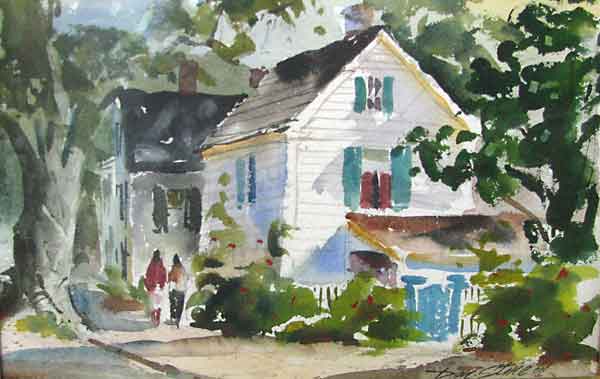
Don Stone, N.A.
The Blue Gate
Watercolor 7 x 11, Frame Size: 13 x 17
$1500
Don Stone began studying art at Gloucester High School and continued at Vesper George School of Art, Boston, to which he later returned as an instructor. He also studied privately with Paul Strisik, N.A., whom he credits with introducing him to the life of a plein-air painter. It was during his youth in Gloucester that Stone became deeply involved with local fishermen. Now, from his studio on Monhegan Island, Maine, he has the opportunity to portray this involvement to its fullest.
Few artists have so successfully mastered so many different paint mediums, and, with each new exploration, presented a fresh means of expression. Working with vigorous, moving watercolor, he captures momentary visual sensations, and an immediacy that is translated into works of stunning accuracy and vitality in the precision of his oils and watercolors. Known for the luminosity in his paintings, Don believes it is not the subject which is important, as much as it is the effect of the light under which it is painted.
Another uniting factor in these skilled and versatile paintings is the distinctly American point of view. Don Stone's deeply rooted respect for the American Tradition of Realism is expressed in his choice of subject from the well-known marine paintings to the rural New England landscapes, both occasionally peopled with characters that embody the very pulse of the American heritage.
Don Stone has been elected to full membership in the National Academy of Design, the American Watercolor Society, as well as the Allied Artists of America, the Hudson Valley Art Asociation, the Guild of Boston Artists, the Copley Society of Boston, the Rockport Art Association, the North Shore Art Association.
|
|
See the calendar for future exhibitions.
|

|
|

